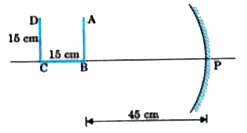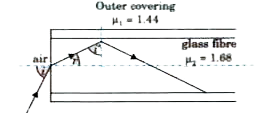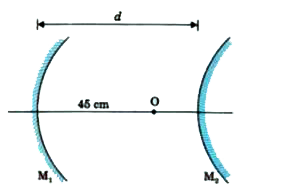Complete Solutions to Tough & Tricky (PROBLEMS) of chapter RAY OPTICS AND OPTICAL INSTRUMENTS of Class 12 book with complete answers and questions
| Class 12 | PHYSICS |
| Chapter | RAY OPTICS AND OPTICAL INSTRUMENTS |
| MODERN PUBLICATION | Tough & Tricky (PROBLEMS) |
| Number Of Questions | 20 |
| Academic Year | 2023-24 |
There is a concave mirror of radius of curvature 30 cm. A U-shaped wire of shown dimensions is placed in front of concave mirror as shown in given figure. Find the total length of the image formed.

View SolutionThere is a concave mirror of focal length 7.5 cm. Two objects P and Q are placed in front of this concave mirror one by one. Heights of the images of P and Q are found to be same. Height of P is double to that of height of Q and is placed at a distance 15 cm from the mirror. At what distance object Q was placed?
View SolutionThere is one cylindrical vessel whose height and diameter are both equal to D. An observer's eye is placed in such a manner that bottom edge of the vessel is just visible to eye.

There is a point P at the bottom of container at a distance x from the centre of container as shown in the figure. Up to what height the liquid of refractive index `mu` should be poured in the vessel so that point P is visible to the eye?
View SolutionA hemispherical portion of the surface of a solid glass sphere (mu = 1.5) of radius r is silvered to make the inner side reflecting. An object is placed on the axis of the hemisphere at a distance 3r from the centre of the sphere. The light from the object is refracted at the unsilvered part, then reflected from the silvered part and again refracted at the unsilvered part. Locate the final image formed.
View SolutionA ray of light passes through a transparent sphere of refractive index `mu` and radius R. If b is the distance between the incident ray and a parallel diameter of
View SolutionA cylindrical glass rod of radius 0.1m and refractive index `sqrt(3)` lies on horizontal plane mirror. A horizontal ray of light moving perpendicular to the axis of the rod is incident on it. At what height from the mirror should the ray be incident so that it leaves the rod at a height of 0.1m above the plane mirror ? At what distance a second similar rod, parallel to the first, be placed on the mirror, such that the emergent ray from the second rod is in line with the incident ray on the first rod ?
View SolutionThe convex surface of a thin concave-convex lens of glass of refractive index 1.5 has a radius of curvature 20 cm. The concave surface has a radius of curvature 60 cm. The convex side is silvered and placed on a horizontal surface as shown in figure. (a) Where should a pin be placed on the axis so that its image is formed at the same place ? (b) If the concave part is filled with water (mu = 4/3), find the distance through which the pin should be moved so that the image of the pin again coincides with the pin.

View SolutionA parallel beam of light travelling in water (refractive index ` =4//3)` is refracted by a spherical air bublle of radius 2mm situated in water. Assuming the light rays to be paraxial,
a. Find the position of image due to refraction at first surface and position of the final image.
b. Draw a ray diagram showing the position of both images.
View SolutionA convex lens of focal length `30 cm` and a concave lens of focal length `60 cm` are placed in combination. If an object is placed `40 cm` away from the combination, find the position of the image.
View Solutionn अपवर्तनांक की एक पारदर्शी बेलनाकार छड़ के एक समतल सिरे पर `alpha` कोण पर प्रकाश आपतित होता है | n का वह न्यूनतम मान ज्ञात कीजिए जिससे छड़ में प्रवेश करने वाला प्रकाश छड़ के वक्र - पृष्ठ से निर्गत न हो चाहे `alpha` का मान कुछ भी क्यों न हो |

View SolutionA ray of light travelling in air is incident at grazing angle (incident angle=`90^(@))` on a long rectangular slab of a transparent medium of thickness `t=1.0` (see figure). The point of incidence is the origin `A(O,O)` .The medium has a variable index of refraction n(y) given by :`n(y)=[ky^(3//2)+1]^(1//2)` ,where k=`1.0m^(-3//2)`.the refractive index of air is 1.0`

(i) Obtain a relation between the slope of the trajectory of the ray at a point `B(x,y)`in the medium and the incident angle at that point
(ii) obtain an equation for the trajectory `y(x)`of the ray in the medium.
(ii) Determine the coordinates (`x_(1),y_(1))` of the point `P`.where the ray the ray intersects upper surface of the slab -air boundary.
Indicate the path of the ray subsequently.
View SolutionA small piece of wood is floating on the surface of a 2.5 m deep lake. Where does the shadow form on the bottom when the sun is just setting? Refractive index of water = 4/3
View SolutionA particle is moving at a constant speed V from a large distance towards a concave mirror of radius R along its principal axis. Find the speed of the image formed by the mirror as a function of the distance x of the particle from the mirror.
View SolutionCross section of a light pipe is shown in the following figure :

Inner core is material of refractive index 1.68 and its outer covering is a material of refractive index 1.44. Find the maximum angle at which the ray can be incident with the axis of pipe for which total internal reflection occurs inside the pipe.
View SolutionA gun of mass M fires a bullet of mass m with a horizontal speed V. The gun is fitted with a concave mirror of focal length f facing towards the receding bullet. Find the speed of separation of the bullet and the image just after the gun was fired.
View SolutionIn case of a concave mirror magnification is found to be `m_(1) = -0.5` for a certain position of object and when object is displaced by 5 cm from this position then magnification is found to be `m_(2) = -0.25`. What will be the focal length of the mirror?
View SolutionIn the following figure two mirrors `M_(1) and M_(2)` are placed in front of each others.

Both the mirrors have same focal length of 30 cm. Mirror `M_(1)` is concave but mirror `M_(2)` is convex. Distance between the two mirrors is d and their principal axes are coinciding as shown in figure. An object O is placed on principal axis at a distance 45 cm from mirror `M_(1)`. It is found that final image is formed on object itself. Calculate the value of d.
View SolutionA square-shaped planar object of edge length 3 cm is placed at a distance 30 cm from a concave mirror. Focal length of the concave mirror is 12 cm. Find area enclosed by image. Centre of the square lies on principal axis and plane of the square is perpendicular to the principal axis.
View SolutionA rod AB of length 5 cm is placed in front of a concave mirror of focal length 10 cm as shown in figure. The length of the image of AB formed by the mirror is

View SolutionThere is a plano-convex lens whose radius of curvature for convex surface is 2.5 cm. Thickness of the lens is 9 cm. When object is placed at a certain distance from the convex surface then image is formed on the plane surface of the lens which serves as screen. What should be the magnification in this case? Refractive index is 1.5.
View Solution
Tough & Tricky (PROBLEMS) questions and complete solutions for chapter RAY OPTICS AND OPTICAL INSTRUMENTS of MODERN PUBLISHERS PHYSICS (HINGLISH) of Class 12
All Exercises from MODERN PUBLICATION Class 12 PHYSICS RAY OPTICS AND OPTICAL INSTRUMENTS
- CHAPTER PRACTICE TEST
- Conceptual Questions
- Higher Order Thinking Skills & Advanced Level (QUESTIONS WITH ANSWERS)
- NCERT (EXemplar Problems Obejective Questions) (Multiple Choice Questions (Type-I)
- NCERT (EXemplar Problems Obejective Questions) (Multiple Choice Questions (Type-II)
- NCERT (Exemplar Problems Subjective Questions) (Very Short Answer Type Questions)
- NCERT FILE SOLVED (TEXT BOOK EXERCISES)
- OBJECTIVE TYPE QUESTIONS (A. MULTIPLE CHOICE QUESTIONS)
- OBJECTIVE TYPE QUESTIONS (ASSERTION REASON TYPE QUESTIONS)
- OBJECTIVE TYPE QUESTIONS (B. MULTIPLE CHOICE QUESTIONS)
- OBJECTIVE TYPE QUESTIONS (C. MULTIPLE CHOICE QUESTIONS)
- OBJECTIVE TYPE QUESTIONS (D. MULTIPLE CHOICE QUESTIONS)
- OBJECTIVE TYPE QUESTIONS (INTEGER TYPE QUESTIONS)
- OBJECTIVE TYPE QUESTIONS (JEE (ADVANCED) FOR IIT ENTRANCE)
- OBJECTIVE TYPE QUESTIONS (JEE (MAIN) & OTHER STATE BOARDS FOR ENGINEERING ENTRANCE)
- OBJECTIVE TYPE QUESTIONS (MATCHING TYPE QUESTIONS)
- OBJECTIVE TYPE QUESTIONS (MATRIX MATCH TYPE QUESTIONS)
- PRACTICE PROBLEMS (1)
- PRACTICE PROBLEMS (10)
- PRACTICE PROBLEMS (11)
- PRACTICE PROBLEMS (2)
- PRACTICE PROBLEMS (3)
- PRACTICE PROBLEMS (4)
- PRACTICE PROBLEMS (5)
- PRACTICE PROBLEMS (6)
- PRACTICE PROBLEMS (7)
- PRACTICE PROBLEMS (8)
- PRACTICE PROBLEMS (9)
- Revision Exercises (Additional Questions)
- Revision Exercises (Fill in the Blanks)
- Revision Exercises (Long Answer Questions)
- Revision Exercises (Numerical Problems)
- Revision Exercises (Short Answer Questions)
- Revision Exercises (Very Short Answer Questions)
- SOLVED EXAMPLES
- Tough & Tricky (PROBLEMS)